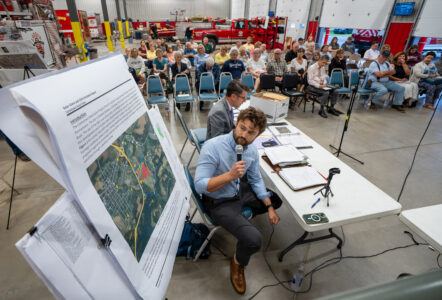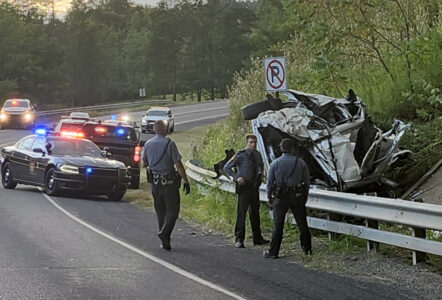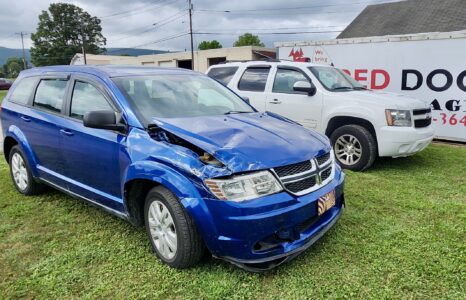Muncy Creek Township hears more testimony about solar proposal
- Jonathan Zartman of Bollinger Solar explains the view blocking plants that are planned to be done for the proposed solar farm along Clarkstown Road during a meeting of the Muncy Creek Township Supervisors at the Muncy Area Volunteer Fire Company. DAVE KENNEDY/Sun-Gazette
- Jonathan Zartman of Bollinger Solar explains the view blocking plants that are planned to be done for the proposed solar farm along Clarkstown Road during a meeting of the Muncy Creek Township Supervisors at the Muncy Area Volunteer Fire Company. DAVE KENNEDY/Sun-Gazette
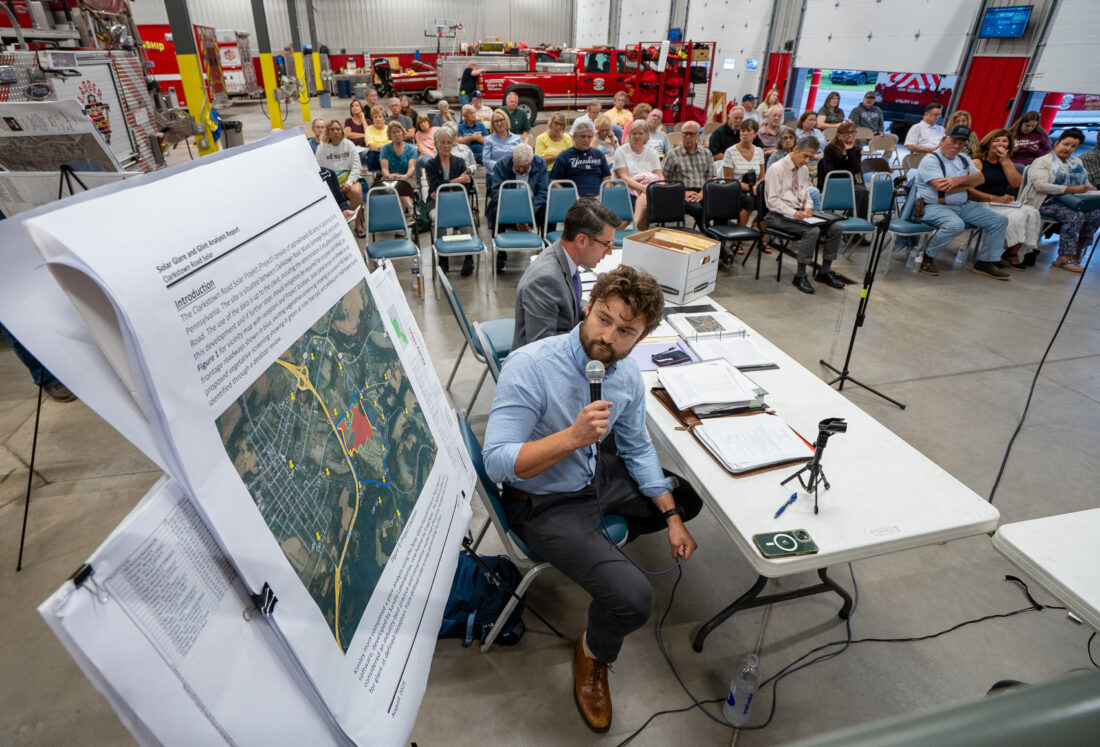
Jonathan Zartman of Bollinger Solar explains the view blocking plants that are planned to be done for the proposed solar farm along Clarkstown Road during a meeting of the Muncy Creek Township Supervisors at the Muncy Area Volunteer Fire Company. DAVE KENNEDY/Sun-Gazette
Bollinger Solar of Lititz continued Wednesday with testimony for its proposed joint “agrivoltaic” project with Sunny Side Up Farms in Muncy Creek Township, Lycoming County, combining solar generation with free-range chicken farming.
This conditional use hearing on the solar portion presented more details on a revised glare/glint study, which included back-and-forth testimony and questions regarding tree buffering, a perimeter barrier of existing and installed trees, and a report by an appraiser citing there is no evidence based on generalized study of samples in Pennsylvania and around the nation that homes near such properly designed solar facilities see negative impacts on their real estate value.
Jonathan Zartman, a solar facilities design engineer with Kimley-Horn, picked back up with his statements in the early part of the three-hour hearing inside Muncy Area Volunteer Fire Co. on East Penn Street.
Later, the board also had Mark Pomykacz, a professional appraiser, be sworn in.
The appraiser, meanwhile, testified as having done a study on properties surrounding solar farms in Pennsylvania and throughout the nation.
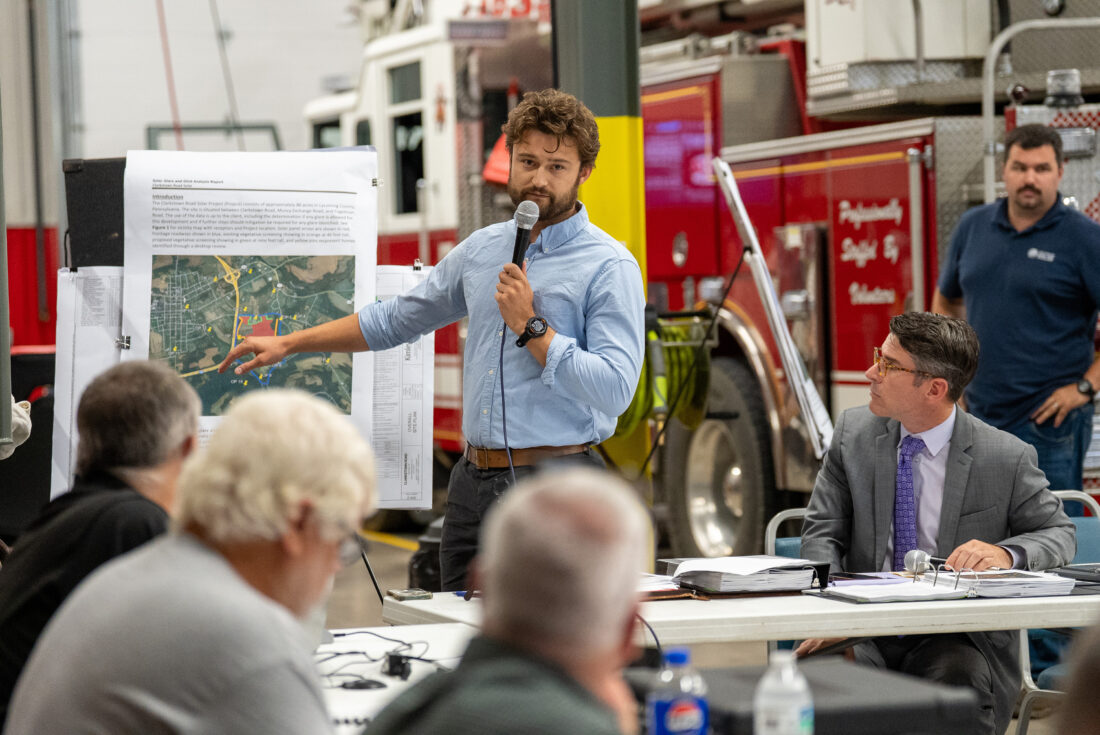
Jonathan Zartman of Bollinger Solar explains the view blocking plants that are planned to be done for the proposed solar farm along Clarkstown Road during a meeting of the Muncy Creek Township Supervisors at the Muncy Area Volunteer Fire Company. DAVE KENNEDY/Sun-Gazette
His conclusion was there was no material impact on the real estate valuation of properties adjacent to these properly designed solar farms.
Pomykacz acknowledged, however, the report was generated weeks before he visited the site, which occurred earlier on the day of the hearing.
“Did you ever visit the site?” Attorney Zachary DuGan, legal counsel for the Muncy Area Neighborhood Preservation Coalition, citizens who are opposed to the proposed CAFO/solar farm, asked.
“Yes,” he said.
“How many times?” DuGan asked.
“Today,” Pomykacz replied.
The appraiser noted to a question that he had not had the opportunity to appraise properties near an “agrivoltaic project.”
What was done was a generalized study not specific for this proposed project use.
Upon questioning, the assessor also admitted most of the appraisals in the report presented were on properties next to solar arrays that were smaller than what is proposed.
Of 30 sites, for example, the vast majority were smaller. An example close to Bollinger’s that was given was a solar farm producing 20 megawatts of electricity.
Bollinger said it proposes a farm producing 33 megawatts of electricity.
Pomykacz reiterated that he did not see any evidence and had no expectations of damages on nearby properties because of solar facilities.
The conclusion of the report was there was no impact to nearby residences of “properly designed” solar facilities.
The phrasing “properly designed” piqued township Solicitor J. Michael Wiley’s interest.
Wiley asked what are the factors in determining properly designed solar facilities?
The answer Pomykacz gave focused on the facility’s managers, the setbacks (putting inverters that make a humming noise away from the nearest homes) and screening – either existing natural buffers or planned additions.
The applicant also submitted supplemental information updating a glare/glint study.
It is part of the record for the township board of Supervisor Eric Newcomer and appointed interim supervisor member, Harley Frey II, to review.
Supervisor Gary Phillips has been asked by legal advisers to recuse himself. Phillips remains on the board and can vote on any other matter.
Not ‘concentrated’ glare
The fixed-tilt solar panels would be on the 11 separate solar sections producing about 3 megawatts each.
In terms of the glare study, the proposed project would not cause “concentrated glare” because the panels are designed to “absorb sunlight,” not “reflect it,” Zartman said.
He also answered questions of resident Howard Williams about whether industry-based or other types of software were used for analysis in the glare study report.
Zartman said, repeating his prior testimony, the glare would be like sunlight on a body of water or snow.
Among several points of inquiry, DuGan asked Zartman to acknowledge that if there were existing trees that were not healthy as part of a perimeter buffer if the applicant would have a vegetative maintenance plan?
“Yes, through the township if the trees needed to be replaced,” he said. Essentially, the applicant did not have a plan for existing buffering as part of a replacement strategy, Zartman said.
Instead, arborvitae of 5 feet would be installed in certain locations as a buffer, according to the plan. The applicant does not want to include a 3-foot berm that would increase the height of the arborvitae to about 8 or 9 feet. That caused problems with drainage in other locations.
Some discussion occurred in a line of questioning by Wiley.
Does the height of the screening, whether it includes the berm plus arborvitae or arborvitae alone impact the amount of glare? Wiley asked.
“Did you factor in how the maturity of the barrier would impact glare?” he asked.
Zartman said the report does not but admitted that could be looked at.
The report indicated the existing buffer is 100 % dense, but it does not account for trees of 40 feet tall, the species that lose leaves in winter, deciduous and coniferous or cone bearing evergreens and shrubs that do not.
The report included 20 points or locations evaluated as part of the glare study. It does not factor in the topography aspects, such as glare that could be blocked by buildings, trees, and the elevation of the land. The software used in the glare report does not model those factors in and because of this the applicant would be open to adding and supplementing to the existing buffer, Zartman added.
Some of the buffer would be for preventing glare as well as for improving the overall visual aspects of the project site, or aesthetics, he said.
Newcomer said the board requests a list of the physical locations in the glare study to add for the hearing record.
Resident Harvey Stauffer
asked Zartman if the deed was looked up in the Lycoming County courthouse who is the owner of the property?
Sunny Side Up Farms intends to purchase the property, township planning minutes said.
The applicant does not need to be the owner of the property, explained Attorney Samuel E. Wiser Jr., who serves as counsel for the applicant.
The proposed project is a joint venture of the Bollinger and Wagner families of Lancaster County and would be called Sunny Side Up Farms, according to the hearing transcript.
Muncy Area Neighborhood Preservation Coalition has said on public posts and shared privately that it has invested thousands of dollars in the form of donations for the legal representation and to bring expert witnesses to provide testimony.
The CAFO, with elements of testimony ranging from the proposed manure management plan, design of barns scraping chicken manure, odor and control and management of flies, what happens if avian disease emerges, ways to prevent biohazard transmission, increased truck traffic, potential impacts to ground water and protection measures and dust and air quality concerns, has drawn far larger crowds.
The solar conditional use hearing will be continued to 7 p.m. Sept. 30, while the conditional use hearing on the CAFO was continued to 7 p.m. Sept. 4.

